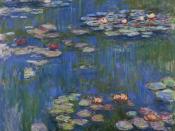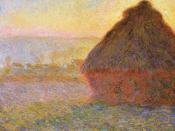Two pieces by Claude Monet at the Museum of Fine Arts which illustrate the artist's range in styles are La Japonaise (1876), and Morning Light rendering of the Rouen Cathedral (1894). The works come at widely different times in the artist's development. There are many obvious differences, and a few subtle similarities.
The first piece is vibrant. The figure is especially real; there is a sense of vitality and fun in the model's twisted form. She is fanning herself playfully with her Japanese fan. One interesting point is that the model is obviously European. She has blonde hair, something out of place with eastern culture. Monet probably did this purposefully, because of Europe's fascination with Japan at the time. It was a reflection of the popular trends of the day. The fan she's holding bears the colours of the French flag, which also adds to the mixing of east and west.
Hue is also an important factor in this painting. The saturated red of the kimono stands out against the drab hue of the background. Also, the warrior on the garment appears to be as alive as Monet's model. The fierceness of the warrior contrasts with the sweetness of the model's face and demeanor. There is a sense of something not so mundane or ordinary about this work. Monet was certainly attempting to create something which captivated the viewer. The way the fans hanging on the wall appear to be floating in midair adds to a sense of make-believe. There is something inherently fun and inviting about this piece.
The cathedral, however, is a much more serious work. It lacks the playfulness of the earlier portrait. The artist seems to be most concerned with the way light is cast on the cathedral, rather than with the immense cathedral itself. Also,



Links to the paintings are here
"La Japonaise"http://www.art-beat-gallery.net/monet-im age/Monet-large/Monet-LaJaponaise.jpg"The Portal of Rouen Cathedral in Morning Light" (note: this is the correct name of the painting!)http://www.getty.edu/art/collections/obj ects/o142049.html
10 out of 12 people found this comment useful.